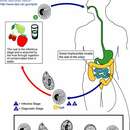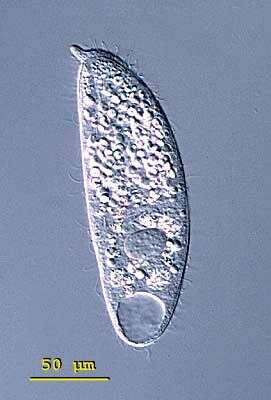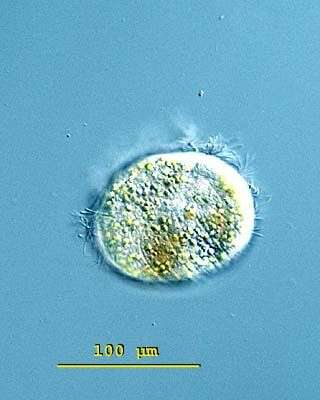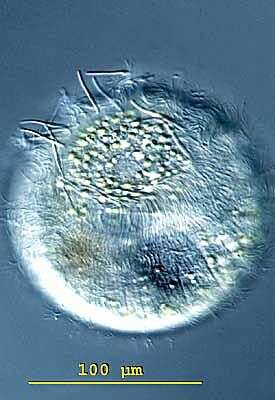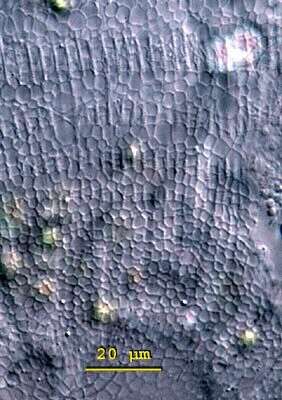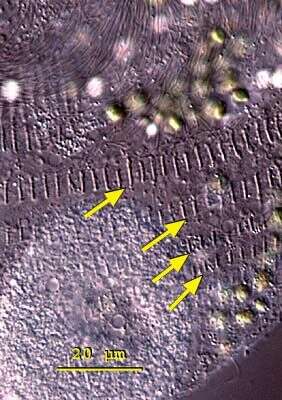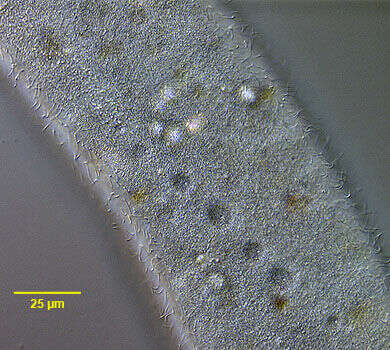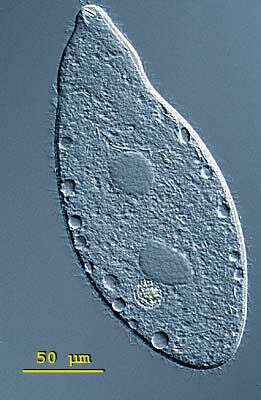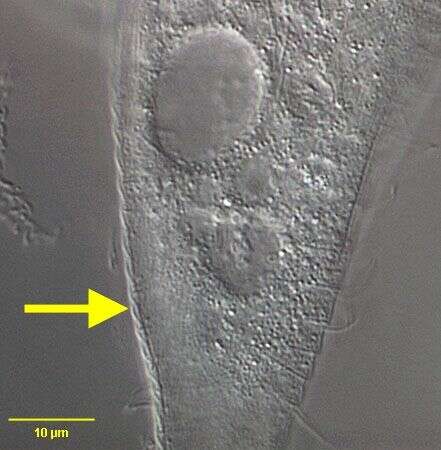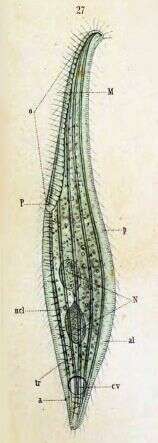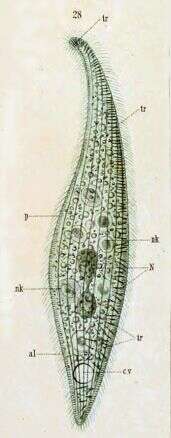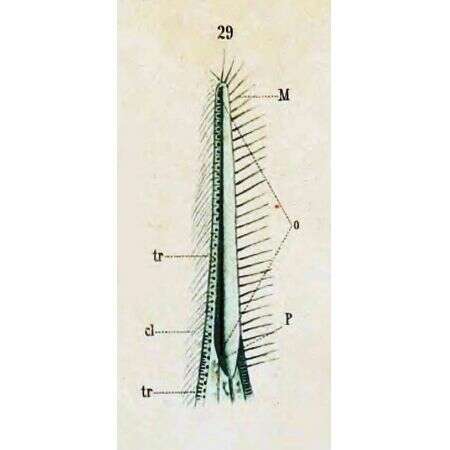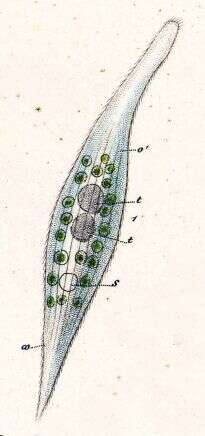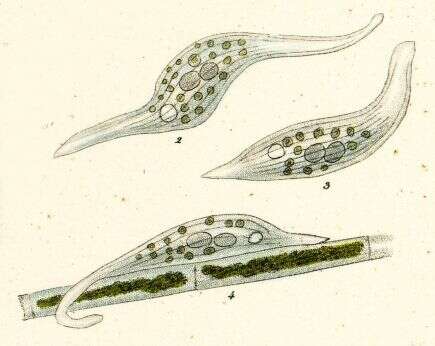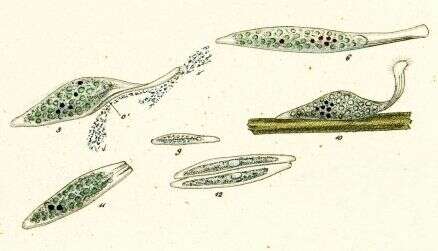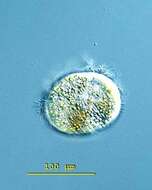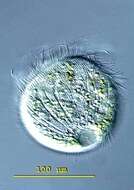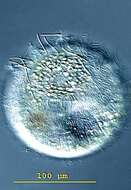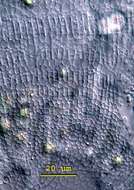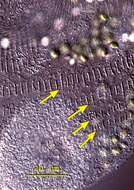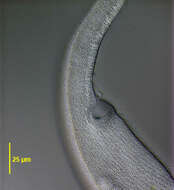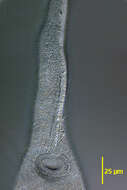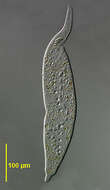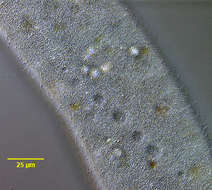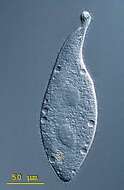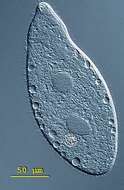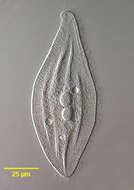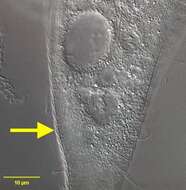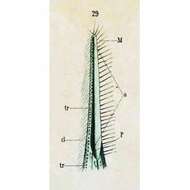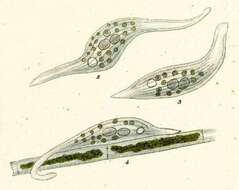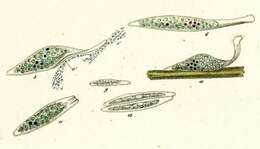-
Spathidium (spa-thid-ee-um) porculus, the body is elongate, the posterior end is bluntly pointed or rounded but the anterior end is distinctively swollen - often fan-shaped and obliquely truncated. There is an ciliated apical ridge which is lined by toxicysts. The oral aperture is a slit that lies along the length of this ridge. The cilia are uniformly distributed in longitudinal parallel rows on both lateral surfaces. The macronucleus is highly variable, often elongate, ribbon-like or moniliform. The contractile vacuole is single and at the end of the cell. Spathidium feeds on other ciliates. It lives in fresh water ponds and lakes. The species is unmistakable because of its nose like projection of the oral apparatus. Slightly squashed cell. 136 microns. Differential interference contrast.
-
Pelagovasicola (pee-ladge-o-vee-sick-o-la) cinctum is a very fast swimming obovoid ciliate measuring 50 - 180 X 40 - 85 microns. It is common in plankton of lakes and ponds. The body is surrounded by 5-7 distinct ciliary girdles. The posterior fifth of the cell is unciliated. The contractile vacuole lies in the posterior end and has about 20 radial collecting channels. The macronucleus is kidney-shaped and lies in the mid-body. Extrusomes are arranged in the margin of the oral dome, occasionally extruded as bundles of fine filaments. This free-swimming specimen was collected in the plankton of a bog pond near Konstanz, Germany. 115 X 92 microns. Differential interference contrast.
-
Pelagovasicola (pee-ladge-o-vee-sick-o-la) cinctum is a very fast swimming obovoid ciliate measuring 50 - 180 X 40 - 85 microns. It is common in plankton of lakes and ponds. The body is surrounded by 5-7 distinct ciliary girdles. The posterior fifth of the cell is unciliated. The contractile vacuole lies in the posterior end and has about 20 radial collecting channels. The macronucleus is kidney-shaped and lies in the mid-body. Extrusomes are arranged in the margin of the oral dome, occasionally extruded as bundles of fine filaments. This slightly squashed specimen was collected in the plankton of a bog pond near Konstanz, Germany, and this images emphasizes the radial collecting channels of the contractile vacuole. Differential interference contrast.
-
Pelagovasicola (pee-ladge-o-vee-sick-o-la) cinctum is a very fast swimming obovoid ciliate measuring 50 - 180 X 40 - 85 microns. It is common in plankton of lakes and ponds. The body is surrounded by 5-7 distinct ciliary girdles. The posterior fifth of the cell is unciliated. The contractile vacuole lies in the posterior end and has about 20 radial collecting channels. The macronucleus is kidney-shaped and lies in the mid-body. Extrusomes are arranged in the margin of the oral dome, occasionally extruded as bundles of fine filaments. This slightly squashed specimen was collected in the plankton of a bog pond near Konstanz, Germany, and this images emphasizes the extruded extrusomes at the margin of the oral dome. Differential interference contrast.
-
Pelagovasicola (pee-ladge-o-vee-sick-o-la) cinctum is a very fast swimming obovoid ciliate measuring 50 - 180 X 40 - 85 microns. It is common in plankton of lakes and ponds. The body is surrounded by 5-7 distinct ciliary girdles. The posterior fifth of the cell is unciliated. The contractile vacuole lies in the posterior end and has about 20 radial collecting channels. The macronucleus is kidney-shaped and lies in the mid-body. Extrusomes are arranged in the margin of the oral dome, occasionally extruded as bundles of fine filaments. This slightly squashed specimen was collected in the plankton of a bog pond near Konstanz, Germany, and this images emphasizes the finely meshed alveolar pattern of the cortex. Differential interference contrast.
-
Pelagovasicola (pee-ladge-o-vee-sick-o-la) cinctum is a very fast swimming obovoid ciliate measuring 50 - 180 X 40 - 85 microns. It is common in plankton of lakes and ponds. The body is surrounded by 5-7 distinct ciliary girdles. The posterior fifth of the cell is unciliated. The contractile vacuole lies in the posterior end and has about 20 radial collecting channels. The macronucleus is kidney-shaped and lies in the mid-body. Extrusomes are arranged in the margin of the oral dome, occasionally extruded as bundles of fine filaments. This slightly squashed specimen was collected in the plankton of a bog pond near Konstanz, Germany, and this images emphasizes the characteristic rows of basal bodies ciliary girdles (arrows). Differential interference contrast.
-
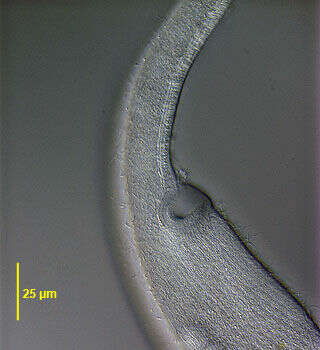
Detail of the oral aperture and ventral proboscis of Monilicaryon monilatus Monilicaryon monilatus (Stokes, 1886) Jankowski, 1967. Similar in overall appearance to Dileptus anser. M. monilatus differs by having a shorter proboscis relative to the length of the body (1/3 to 1/4) and by lacking the row of obliquely oriented closely spaced kinetids on the ventral aspect of the left side of the proboscis (this feature requires demonstration by DIC or protargol staining). M. monilatus has two single files of kinetids extending from either side of the oral aperture anteriorly along the ventral aspect of the proboscis separated by a strip bearing extrusomes (See Foissner W., Berger H and Kohmann F. Taxonomische und ökologische Revision der Ciliaten des Saprobiensystems- Band IV: Gymnostomatea, Loxodes, Suctoria. Informationsberichte Bayer. Landesamtes für Wasserwirtschaft. 1/95:185-202, 1995). In this image the two parallel kineties along the right side of the extrusome strip are visible. Collected from a freshwater pond near Boise, Idaho. DIC.
-
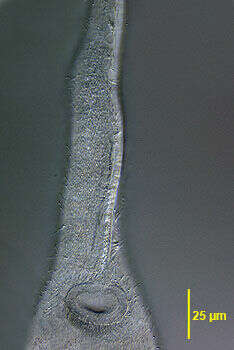
Detail of the oral aperture and ventral proboscis of Monilicaryon monilatus Monilicaryon monilatus (Stokes, 1886) Jankowski, 1967. Similar in overall appearance to Dileptus anser. M. monilatus differs by having a shorter proboscis relative to the length of the body (1/3 to 1/4) and by lacking the row of obliquely oriented closely spaced kinetids on the ventral aspect of the left side of the proboscis (this feature requires demonstration by DIC or protargol staining). M. monilatus has two single files of kinetids extending from either side of the oral aperture anteriorly along the ventral aspect of the proboscis (See Foissner W., Berger H and Kohmann F. Taxonomische und ökologische Revision der Ciliaten des Saprobiensystems- Band IV: Gymnostomatea, Loxodes, Suctoria. Informationsberichte Bayer. Landesamtes für Wasserwirtschaft. 1/95:185-202, 1995). In this image the area between these kineties appears more refractile due to the presence of extrusomes. Collected from a freshwater pond near Boise, Idaho. DIC.
-
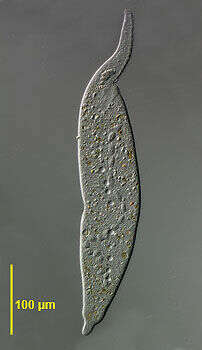
Portrait of the large ciliate, Monilicaryon monilatus (Stokes, 1886) Jankowski, 1967. This cell is slightly compressed. Similar in overall appearance to Dileptus anser. M. monilatus differs by having a shorter proboscis relative to the length of the body (1/3 to 1/4) and by lacking the row of obliquely oriented closely spaced kinetids on the ventral aspect of the left side of the proboscis (this feature requires demonstration by DIC or protargol staining). M. monilatus has two single files of kinetids extending from either side of the oral aperture anteriorly along the ventral aspect of the proboscis separated by a strip bearing extrusomes (See Foissner W., Berger H and Kohmann F. Taxonomische und ökologische Revision der Ciliaten des Saprobiensystems- Band IV: Gymnostomatea, Loxodes, Suctoria. Informationsberichte Bayer. Landesamtes für Wasserwirtschaft. 1/95:185-202, 1995). The moniliform macronucleus is seen here. There are 20-40 small dorsal contractile vacuoles each emptying through a single excretory pore. There is often a larger contractile vacuole at the base of the tail. Collected from a freshwater pond near Boise, Idaho. DIC.
-
Detail of the dorsal surface of Monilicaryon monilatus (Stokes, 1886) Jankowski, 1967 showing the single excretory pore of several of the 20 to 40 small contractile vacuoles(See Foissner W., Berger H and Kohmann F. Taxonomische und ökologische Revision der Ciliaten des Saprobiensystems- Band IV: Gymnostomatea, Loxodes, Suctoria. Informationsberichte Bayer. Landesamtes für Wasserwirtschaft. 1/95:185-202, 1995). There is often a larger contractile vacuole at the base of the tail. Collected from a freshwater pond near Boise, Idaho. DIC.
-
Amphileptus (am-fee-lep-tus) claparedii. The body of the members of the genus Amphileptus is laterally compressed and elongate. The oral aperture is a slit on the convex edge of the neck region, and extends less than halfway down the body. Ciliation is present on both lateral surfaces although there is a tendency to some reduction on the left surface. Ciliation on the right surface is extensive and forms longitudinal rows which converge on each other in the anterior region. Trichocysts are common - particularly in neck. Macronucleus in 2 to 4 spherical parts with single micronucleus placed between macronuclei. Many contractile vacuoles occur along both dorsal and ventral edges. Lives in fresh water ponds and lakes. Slightly squashed specimen of Amphileptus claparadeii. Macronuclei and the contractile vacuoles located at the edges are visible. Measuring 230 microns. Differential interference contrast.
-
Amphileptus (am-fee-lep-tus) claparedii. The body of the members of the genus Amphileptus is laterally compressed and elongate. The oral aperture is a slit on the convex edge of the neck region, and extends less than halfway down the body. Ciliation is present on both lateral surfaces although there is a tendency to some reduction on the left surface. Ciliation on the right surface is extensive and forms longitudinal rows which converge on each other in the anterior region. Trichocysts are common - particularly in neck. Macronucleus in 2 to 4 spherical parts with single micronucleus placed between macronuclei. Many contractile vacuoles occur along both dorsal and ventral edges. Lives in fresh water ponds and lakes. Squashed specimen of Amphileptus claparadeii. Macronuclei and the contractile vacuoles located at the edges are visible. Measuring 230 microns. Differential interference contrast.
-
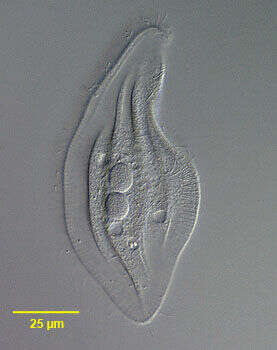
Portrait (left side) of the rhabdophorine ciliate, Siroloxophyllum utriculariae (Penard,1922) Foissner,1995. Siroloxophyllum was erected as a new genus based on the "adoral bulge" which encircles almost the entire circumference of the cell, a single dorsolateral brush kinety and morphologically distinct right and left Dorsolateral kineties different from other somatic kineties. The strongly laterally compressed cell is lancet shaped in outline. The cell is slightly contractile and highly flexible. The rounded anterior end is curved dorsally. The posterior is bluntly tapered. The flat right side bears 13-20 longitudinal kineties. The left side has 3-8 prominent longitudinal ridges (seen here) bearing short cilia. The slit-like cytostome is located along the anteroventral edge. A hyaline band containing long rod shaped extrusomes borders the cell. There is a distinctive structure which looks like a helix or twisted cord bordering the entire edge of the cell except for a short length of the anterior dorsal end. This is best seen at the ventral anterior end in this image (viewer's left). The perpendicularly arranged peripheral extrusomes appear to anchor their exterior ends in this structure. There are two contractile vacuoles (seen here), the anterior one just ventral to the macronuclei and the posterior one located dorsally. A food vacuole is seen immediately posterior to the macronucleus here. The central macronucleus is bipartite. The inconspicuous micronucleus is located between the two parts of the macronucleus. S. utriculariae swims slowly, gliding gracefully over the substrate. Differentiated from the similar L. helus by absence of trichocyst warts along the dorsal surface. Most easily confused with Amphileptus species which lack the distinctive bordering cord-like structure described above except for a short part of the anterior ventral surface and also have an anterior kinetal suture (spica) on the right surface. S. utriculariae may also be confused with Litonotus species which usually have a single contractile vacuole and extrusomes limited to only part of the ventral surface. Collected from a freshwater dredge pond near Boise, Idaho October 2004. DIC.
-
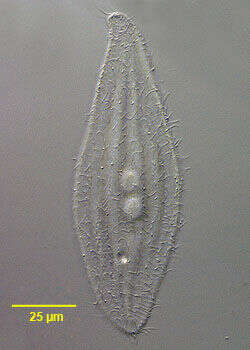
Portrait (right surface) of the rhabdophorine ciliate, Siroloxophyllum utriculariae (Penard,1922) Foissner,1995. Siroloxophyllum was erected as a new genus based on the "adoral bulge" which encircles almost the entire circumference of the cell, a single dorsolateral brush kinety and morphologically distinct right and left Dorsolateral kineties different from other somatic kineties. The strongly laterally compressed cell is lancet shaped in outline. The cell is slightly contractile and highly flexible. The rounded anterior end is curved dorsally. The posterior is bluntly tapered. The flat right side bears 13-20 longitudinal kineties. The left side has 3-8 prominent longitudinal ridges bearing short cilia. The slit-like cytostome is located along the anteroventral edge. A hyaline band containing long rod shaped extrusomes borders the cell. There is a distinctive structure which looks like a helix or twisted cord bordering the entire edge of the cell except for a short length of the anterior dorsal end. The perpendicularly arranged peripheral extrusomes appear to anchor their exterior ends in this structure. There are two contractile vacuoles. The central macronucleus is bipartite. The inconspicuous micronucleus is located between the two parts of the macronucleus (not seen here). S. utriculariae swims slowly, gliding gracefully over the substrate. Differentiated from the similar L. helus by absence of trichocyst warts along the dorsal surface. Most easily confused with Amphileptus species which lack the distinctive bordering cord-like structure described above above except for a short part of the anterior ventral surface and also have an anterior kinetal suture (spica) on the right surface. May also be confused with Litonotus species which usually have a single contractile vacuole and extrusomes limited to only part of the ventral surface. Collected from a freshwater dredge pond near Boise, Idaho October 2004. DIC.
-

Portrait (right side) of the pleurostomatid ciliate, Siroloxophyllum utriculariae (Penard,1922) Foissner,1995. Siroloxophyllum was erected as a new genus based on the "oral bulge" which encircles almost the entire circumference of the cell, a single dorsolateral brush kinety and morphologically distinct right and left dorsolateral kineties different from other somatic kineties. The strongly laterally compressed cell is lancet shaped in outline. The cell is slightly contractile and highly flexible. The rounded anterior end is curved dorsally. The posterior is bluntly tapered. The flat right side bears 13-20 longitudinal kineties. The basal bodies of one of the perioral kineties are seen well here along the ventral (viewer's right) margin. The left side has 3-8 prominent longitudinal ridges bearing short cilia. The slit-like cytostome is located along the anteroventral edge. A hyaline band borders the cell. There is a distinctive structure which looks like a helix or twisted cord bordering the entire edge of the cell except for a short length of the anterior dorsal end. This is best seen at the anterior end in this image. The perpendicularly arranged peripheral extrusomes appear to anchor their exterior ends in this structure except in a short portion of the dorsal anterior edge where extrusomes and the string-like structure bordering the cell edge are absent. SEM studies suggest that all pleurostomatid ciliates have a string-like structure on the cell margin but in other genera this occupies 1/2 the cell circumference or less. There are two contractile vacuoles (seen here), the anterior one just ventral to the macronuclei and the posterior one located dorsally. The central macronucleus is bipartite. The inconspicuous micronucleus (seen here) is located between the two parts of the macronucleus. S. utriculariae swims slowly, gliding gracefully over the substrate. Differentiated from the similar L. helus by absence of trichocyst warts along the dorsal surface. Most easily confused with Amphileptus species which lack the distinctive bordering cord-like structure around most of its circumference and also have an anterior kinetal suture (spica) on the right surface. S. utriculariae may also be confused with Litonotus species in which the oral bulge is limited to the anterior end of the ventral side. Collected from a freshwater dredge pond near Boise, Idaho October 2004. DIC.
-
The oral bulge of this genus extends from the anterior end around the circumference of the cell to the anterior part of the dorsal side stopping short of the anterior apex on the dorsal side. This feature is the main distinguishing feature of the genus. In other pleurostomatid genera the oral bulge, although similar in structure, extends no furthe than the posterior end of the ventral side. The oral bulge has the appearance of a helical structure or a two stranded string. The yellow arrow in this image indicates the oral bulge along the dorsal edge of the cell. It is likely that only the anterior portion of the oral bulge on the ventral surface opens during feeding. DIC.
-
(Originally described under the name Lionotus fasciola). a -- Anus al -- Pellicular alveoli cv -- Contractile vacuole M -- Mane, made up of a series of stronger cilia N -- Macronucleus ncl -- Micronucleus o -- Mouth p -- Pellicle P -- Peristome tr -- Trichocysts
-
(Originally described under the name Lionotus fasciola) View of the right side. Key to Schewiakoff's abbreviations: al -- Pellicular alveoli cv -- Contractile vacuole N -- Macronucleus nk -- Food particles p -- Pellicle tr -- Trichocysts
-
(Originally described under the name Lionotus fasciola) Anterior, ventral view. Key to Schewiakoff's abbreviations: cl -- Cilia M -- Mane, consisting of a series of stronger cilia o -- Mouth P -- Peristome tr -- Trichocysts
-
Originally described by Ehrenberg under the name Amphileptus fasciola.
-
Originally described by Ehrenberg under the name Amphileptus fasciola.
-
Originally described by Ehrenberg under the name Amphileptus fasciola.
-
Ventral infraciliature of the haptorid ciliate, Monodinium balbianii (Fabre-Domergue, 1888). The dorsal side is distinguished by the five parallel rows of clavate (club-shaped) cilia (the dorsal brush) just posterior to the anterior wreath of ciliated basal bodies. The longitudinal files of somatic kinetosomes (seen here) are unciliated except for the dorsal brush (not seen in this ventral view) and the obliquely inclined closely spaced ciliated basal bodies that form the ciliary girdle. Darkly stained extrusomes are visible here. Collected from a freshwater pond near Boise, Idaho March 2005. Stained by the silver carbonate technique (see Foissner, W. Europ. J. Protistol., 27:313-330;1991). Brightfield.
-
Dorsal infraciliature of the haptorid ciliate, Monodinium balbianii (FABRE-DOMERGUE, 1888). The dorsal side is distinguished by the five parallel rows of clavate (club-shaped) cilia (the dorsal brush) just posterior to the anterior wreath of ciliated basal bodies. The longitudinal files of somatic kinetosomes (not seen well here) are unciliated except for the dorsal brush and the obliquely inclined closely spaced ciliated basal bodies that form the ciliary girdle. Darkly stained extrusomes are visible here. Collected from a freshwater pond near Boise, Idaho March 2005. Stained by the silver carbonate technique (see Foissner, W. Europ. J. Protistol., 27:313-330;1991). Brightfield.

